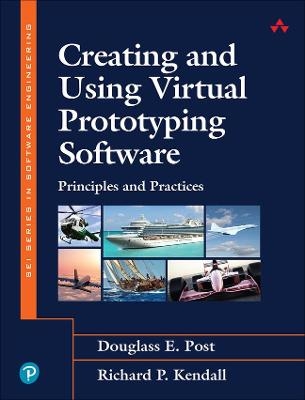
Creating and Using Virtual Prototyping Software
Addison Wesley (Verlag)
978-0-13-656693-9 (ISBN)
- Titel z.Zt. nicht lieferbar
- Versandkostenfrei innerhalb Deutschlands
- Auch auf Rechnung
- Verfügbarkeit in der Filiale vor Ort prüfen
- Artikel merken
Organizations must reduce time-to-market, costs, and risks while producing higher-quality products that grow ever more complex. In response, many are turning to advanced software for rapidly creating and analyzing virtual prototypes, and accurately predicting the performance and behavior of the systems they represent. This requires a deep understanding of physics-based digital engineering and high-performance computing, as well as unique organizational and management skills. Now, Douglass Post and Richard Kendall bring together knowledge that engineers, scientists, developers, and managers will need to build, deploy, and sustain these specialized applications—including information previously available only in proprietary environments.
Post and Kendall illuminate key issues with a detailed book-length case study based on their work at the U.S. DoD's pioneering Computational Research and Engineering Acquisition Tools and Environments (CREATE) program, which developed eleven of the field's most advanced software tools.
You'll find a detailed roadmap for planning, organizing, managing, and navigating complex organizations to successful delivery; as well as detailed descriptions of each step in the process, with clear rationales and concrete examples. The authors share detailed references, a convenient glossary and bibliography, sidebars on overcoming real-world challenges, and more. The book reviews the essentials of computational engineering and science and the pivotal role of virtual prototyping. It helps readers to:
Plan and manage the paradigm shift from physical to virtual prototyping
Establish, execute, and evolve Agile processes for developing virtual prototyping software
Understand and implement virtual prototyping tools and workflows
Verify and validate prototyping systems to ensure accuracy and utility
Recruit and retain a specialized workforce, and train and support users
Explore additional emerging roles for virtual prototyping
Dr. Douglass E. Post was the Chief Scientist of the DoD High Performance Computing Modernization Program from 2005 to 2014 and was a Principal Researcher at the Carnegie Mellon University Software Engineering Institute from 2016 to 2020. His major professional interest for almost 50 years has been the development and application of physics-based software to solve physics and engineering design and analysis problems. In 2005, he established and led the DoD Computational Research and Engineering Acquisition Tools and Environments (CREATE) program, a multiyear DoD program to develop and deploy physics-based computational engineering software for the design of ships, air vehicles, ground vehicles, and RF antennas. He is the Associate Editor-in-Chief of the AIP/IEEE publication Computing in Science and Engineering. Doug received a Ph.D. in physics from Stanford University in 1975. He led the tokamak modeling group at Princeton Plasma Physics Laboratory (1975–1993), the International Thermonuclear Experimental Reactor (ITER) Physics Project Unit (1988–1990), and the ITER Joint Central Team In-vessel Physics Group (1993–1998). More recently, he led the Lawrence Livermore National Laboratory A&X Division (1998–2000) and Los Alamos National Laboratory (2001–2003) Programs to develop physics-based computer simulations for the design of nuclear weapons. He is the author of nearly 250 scientific and engineering publications and a Fellow of the APS, ANS, and IEEE; an AIAA Associate Fellow; and the recipient of ASNE 2011 Gold Medal. Dr. Richard P. Kendall is a software engineering consultant with the DoD High Performance Computer Modernization Program (HPCMP). He has more than 50 years of experience in applications of computational mathematics to engineering problems. After graduating from Rice University in 1972, he joined Esso Production Research Co. (now Exxon Mobil) as a Senior Research Mathematician. There he was directly involved in the development of physics-based reservoir simulators, the enablers of early virtual prototypes of petroleum reservoirs. During the early 1980s, he helped start an ISV to develop high-performance software modeling tools for the international oil market, specifically state-owned companies that lacked the expertise of oil industry leaders such as ExxonMobil. This startup was eventually sold to Western Atlas International (now Schlumberger), where Dr. Kendall became the Senior Vice President and Chief Operating Officer of the Western Atlas Software Division. In the mid-1990s, he joined Los Alamos National Laboratory as a team leader for Oil & Gas Programs. In 1996, he was appointed Director of the Computational Testbed for Industry. This DOE User Facility provided U.S. companies such as Procter & Gamble access to state-of-the art supercomputers of the 1990s (for example, the Thinking Machines CM-5). Later at Los Alamos, he was appointed Chief Information Officer of the Laboratory. In 2007, he followed Dr. Douglass Post to the HPCMP CREATE program, where he still consults. He is a member of IEEE and SPE/AIME and has published in the fields of numerical analysis, petroleum engineering, information technology, and software engineering.
Preface
Chapter 1: The Power of Physics-Based Software for Engineering and Scientific Research
Chapter 2: The Computing Ecosystem
Chapter 3: Getting the Right Software for the Virtual Prototyping Paradigm
Chapter 4: Examples of Virtual Prototyping Software (Tools)
Chapter 5: Applying Virtual Prototyping Tools to Develop Product and Conduct Research
Chapter 6: Developing and Marketing a Proposal to Establish a Program to Develop Virtual Prototyping Tools
Chapter 7: Creating and Sustaining Software Development Programs for Virtual Prototyping Tools
Chapter 8: Managing the Software Development Program for Virtual Prototyping Applications
Chapter 9: Executing a Software Development Program for Virtual Prototyping Applications
Chapter 10: Verifying and Validating Science-Based Software
Chapter 11: Recruiting and Retaining the Workforce
Chapter 12: Opportunities and Challenges for Virtual Prototyping in Engineering and Science
Appendix A: Postscript
Appendix B: References by Chapter
Appendix C: Glossary
Index
| Erscheinungsdatum | 23.12.2021 |
|---|---|
| Reihe/Serie | SEI Series in Software Engineering |
| Verlagsort | Boston |
| Sprache | englisch |
| Maße | 100 x 100 mm |
| Gewicht | 570 g |
| Themenwelt | Mathematik / Informatik ► Informatik |
| ISBN-10 | 0-13-656693-6 / 0136566936 |
| ISBN-13 | 978-0-13-656693-9 / 9780136566939 |
| Zustand | Neuware |
| Informationen gemäß Produktsicherheitsverordnung (GPSR) | |
| Haben Sie eine Frage zum Produkt? |
aus dem Bereich


